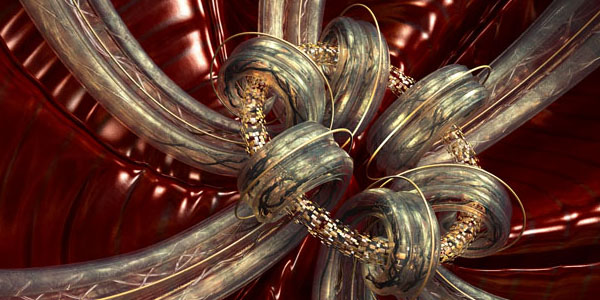
The SIGGRAPH 2009 conference this year is trying out a new exhibition theme in the form of the "information aesthetics showcase". In the interview with infosthetics posted a while ago, the showcase curator Victoria Szabo revealed how this came about: the conference jury saw a lot of amazing information-driven work that did not fit the specific theme of the show, or demonstrate any one sufficiently new technical element to make it fit something like the Emerging Technologies venue either, although the works were worthwhile to be seen at the conference. Hence, the information aesthetics showcase was born, as "a place to show that fascinating work that talked back to the data, engaged it, transformed your understanding".
The new theme consists of 2 panel sessions, an art exhibition (description coming soon) and the keynote talk by Steven Nuebes.
Unfortunately, I missed the morning panel. Monday morning 8.30am proved to be to early for recuperating from a +20 hours flight and a -15 hours jet lag, registering on site and finding the correct location. However, the panelists lineup was impressive: Moritz Stefaner explained the Eigenfactor project, Norah Zuniga Shaw and Maria Palazzi showed Synchronous Objects, and Evan Tice presented Greenlite Dartmouth. Feedback from people who actually attended seemed to be unanimously positive, with a general consensus, from people independent from each other, that the Synchronous Objects project, which was the product of an elaborate three year long collaboration with choreographer William Forsythe, showed an unexpected depth and richness that it definitely requires a revisit for any information aesthetics fan. Moritz Stefaner shared his design process, including sketches of paths not taken and very intriguing "outtakes" resulting from coding errors. Unfortunately, Lorie Loeb, director of the Greenlite Dartmouth project, was not able to be there. Her collaborator, recent graduate Evan Tice, explained how the emotional resonance of the plight of a polar bear, can influence people's awareness of their use of energy.
The afternoon panel had some issues of its own. A continuous bad audio feed made some audience members cringe and even leave. The panel members' presentations (of which I myself was part) did barely touch each other, and might have made the topic seem overly broad and complex.
Michael Kelly, aesthetics expert and professor of Philosophy at the University of North Carolina at Charlotte, described the issues involved in interpreting aesthetics in several relevant fields. He defined aesthetics as the "critical thinking about the norms (standards) of our cognitive and affective experiences in art, culture and nature" but also "in the interactivity that connects humans and computers", which always more apt than talking about just beauty and subjectivity. The use of sensible aesthetics in data visualization is required as data is non-sensuous in 2 ways: data processing can remain inaccessible to our senses (e.g. invisible) and data needs not generate or have any sensuous forms (besides code). Secondly, to be experienced or to generate experiences, and become intelligible, data has to take on some sort of sensuous form. This is the true challenge for visualization: finding the most suitable and enjoyable metaphor for essential non-visual insights.
Victoria Vesna explained the process behind her latest project The Katrina Project: NO-LA. NO-LA involves collaborators from art, design, behavioral science, journalism, and community outreach. A database-driven, activist web site explores the psychological and social effects of the storm and its aftermath through interviews with, and works by various artists in New Orleans and Los Angeles. It is also based on material and information about the Katrina disaster retrieved by undergraduate students, which was then designed into infographical posters. The website aims to become a database of works by moviemakers, photographers, and others in the creative community that work around the topic of Katrina.
Paul Fishwick, editor of the book Aesthetic Computing, discussed this very topic from the viewpoint of teaching a creative computer science course. Computing, seen as mathematical structures such as data and structure (e.g. sequence, branching, iteration, encapsulation), can be seen as possessing aesthetic qualities. Here, aesthetic is more about input/output and about structure, as software can have a wide audience. Software is as much about experience and interaction as about analysis and performance.
The fourth speaker was yours truly, showing the wide spectrum of information aesthetic works, a model that suggest 3 criteria for information aesthetics, and potential useful usages for data visualization applications in the future.
The last speaker, Kenneth Huff, showed his intriguing works of computational art, of which the image above is only a small example. In search of truly random data without repetition, he discovered the beauty of real data, here in the form of prime numbers. His works are not really data representations, but use abstract data as a sort of genetic material or raw material foundation for further algorithmic and visual treatment. Inspired by the random, yet structured beauty and minute details of nature (flora, fauna and mineral), multitudes of objects often are included in works, frequently similar in form, yet always unique in their details.

-----
 Via Information aesthetics
Via Information aesthetics
Personal comment:
Une série de liens et de noms en relation avec l'"Information/data design". Dans le cadre d'une exposition lors de Siggraph 2009. Avec un projet développé par le chorégraphe William Forsythe (un des meilleurs chorégraphe contemporain, labellé toutefois "néo-classique").

